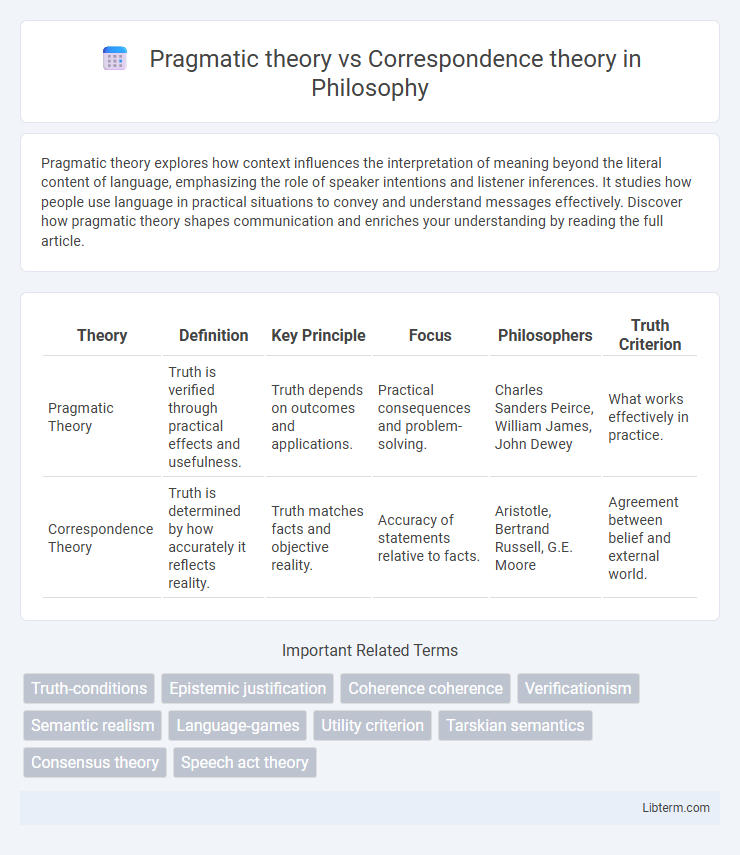Pragmatic theory explores how context influences the interpretation of meaning beyond the literal content of language, emphasizing the role of speaker intentions and listener inferences. It studies how people use language in practical situations to convey and understand messages effectively. Discover how pragmatic theory shapes communication and enriches your understanding by reading the full article.
Table of Comparison
| Theory | Definition | Key Principle | Focus | Philosophers | Truth Criterion |
|---|---|---|---|---|---|
| Pragmatic Theory | Truth is verified through practical effects and usefulness. | Truth depends on outcomes and applications. | Practical consequences and problem-solving. | Charles Sanders Peirce, William James, John Dewey | What works effectively in practice. |
| Correspondence Theory | Truth is determined by how accurately it reflects reality. | Truth matches facts and objective reality. | Accuracy of statements relative to facts. | Aristotle, Bertrand Russell, G.E. Moore | Agreement between belief and external world. |
Understanding Pragmatic Theory: An Overview
Pragmatic theory emphasizes the meaning of statements based on their practical consequences and real-world applications, focusing on how beliefs guide action and produce observable outcomes. It contrasts with Correspondence theory, which defines truth by the alignment between statements and objective reality. Understanding Pragmatic theory involves recognizing its dynamic, context-dependent approach to truth as a tool for problem-solving and effective communication.
Key Concepts of Correspondence Theory
Correspondence theory centers on the key concept that truth is determined by how accurately a statement reflects objective reality or facts. It emphasizes a direct relationship between language and the external world, asserting that a proposition is true if it corresponds to actual states or conditions. This theory contrasts with pragmatic approaches by prioritizing factual accuracy over practical consequences or usefulness in defining truth.
Historical Background of Both Theories
The Correspondence theory of truth dates back to ancient Greek philosophy, prominently developed by Aristotle, who emphasized a statement's truth as its alignment with objective reality. Pragmatic theory emerged in the late 19th and early 20th centuries through American philosophers like Charles Sanders Peirce, William James, and John Dewey, focusing on the practical consequences and workability of beliefs as the criteria for truth. These differing historical contexts reflect the evolution from classical metaphysical inquiry to a more functional and outcome-based understanding of truth.
Core Differences: Pragmatic vs Correspondence Views
Pragmatic theory evaluates truth based on practical consequences and usefulness in real-world applications, emphasizing the functionality of beliefs and statements. Correspondence theory defines truth as the alignment or correspondence between statements and objective reality or facts, focusing on an agreement with an external standard. Core differences lie in pragmatism's focus on utility and outcomes versus correspondence's emphasis on accuracy and factual representation.
How Pragmatic Theory Defines Truth
Pragmatic theory defines truth based on the practical consequences and usefulness of beliefs or statements in real-world applications, emphasizing verification through experience and outcomes. It asserts that a proposition is true if it works satisfactorily and effectively solves problems in specific contexts, linking truth to human action and adaptability. This contrasts with Correspondence theory, which holds truth as a relation of accurately reflecting objective reality or facts independent of practical effects.
Truth According to Correspondence Theory
Truth according to Correspondence Theory is defined by the accurate alignment of statements or beliefs with objective reality or facts. This theory holds that a proposition is true if it corresponds to a fact or a state of affairs in the external world, emphasizing an objective standard of truth. Pragmatic theory, in contrast, assesses truth based on practical consequences and usefulness, rather than strict factual correspondence.
Strengths and Criticisms of Pragmatic Theory
Pragmatic theory emphasizes the practical effects and usefulness of beliefs in guiding actions, offering strength in its adaptability to various contexts and focus on outcomes rather than abstract truth. It addresses ambiguities inherent in language and thought by linking meaning to tangible consequences, making it relevant in daily decision-making and scientific inquiry. Critics argue that pragmatic theory risks relativism, as truth becomes variable depending on practical success, and it may overlook objective facts independent of human utility.
Strengths and Criticisms of Correspondence Theory
Correspondence theory's primary strength lies in its clear criterion of truth, which asserts that a statement is true if it accurately reflects objective reality, providing a straightforward method to evaluate factual claims. Critics argue this theory struggles with abstract concepts, subjective experiences, and situations where reality is not fully accessible or observable, limiting its applicability beyond empirical facts. The theory also faces challenges in addressing the complexity of language and the context-dependency of meaning, which can cause discrepancies between statements and the states of affairs they aim to describe.
Real-World Applications: Pragmatic vs Correspondence
Pragmatic theory emphasizes the practical consequences and usefulness of beliefs, making it ideal for fields like law, education, and technology where outcomes drive truth validation. Correspondence theory, centered on the alignment between statements and objective reality, is crucial in scientific research, journalism, and forensic analysis for verifying factual accuracy. Real-world applications of pragmatic theory prioritize actionable results, whereas correspondence theory ensures truth through empirical evidence and factual correctness.
Choosing a Theory: Implications for Knowledge and Belief
Choosing between Pragmatic and Correspondence theories profoundly impacts the understanding of knowledge and belief; the Pragmatic theory evaluates truth based on practical consequences and usefulness, emphasizing beliefs that work in real-life applications. In contrast, the Correspondence theory defines truth as the accurate representation of reality or facts, prioritizing objective verification and alignment with external states. This choice influences epistemological approaches, shaping how knowledge claims are justified and beliefs validated in diverse contexts.
Pragmatic theory Infographic

 libterm.com
libterm.com